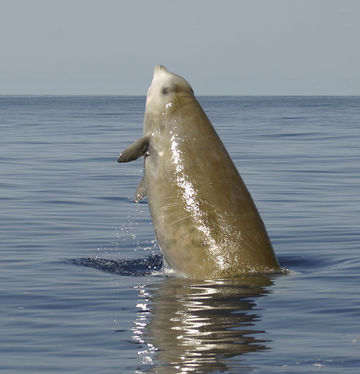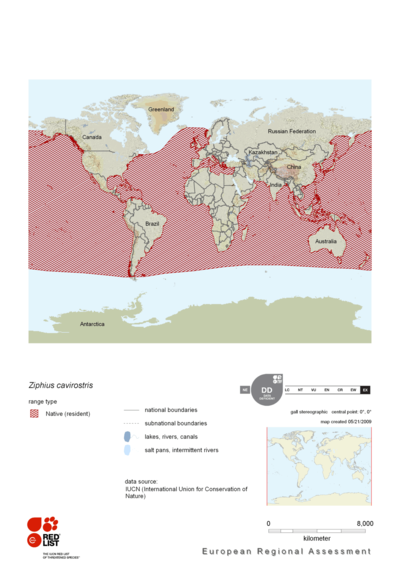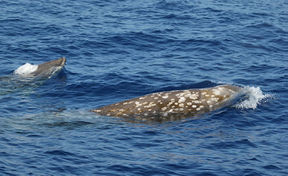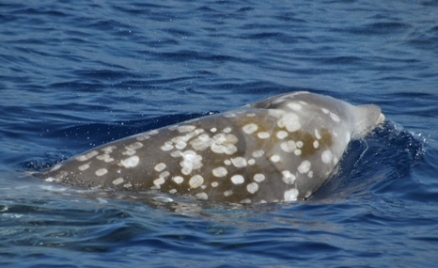Cuvier’s beaked whale
Cuvier's beaked whale (Scientific name: Ziphius cavirostris) is one of 21 species of beaked whales (Hyperoodontidae or Ziphiidae), medium-sized whales with distinctive, long and narrow beaks and dorsal fins set far back on their bodies. They are marine mammals within the order of cetaceans.
Article was partially created as part of the Student Science Communication Project, by a student from Salem State College. All SSCP articles have been reviewed by internal EoE editors.
Very seldom seen at sea, almost everything known about Cuvier's beaked whale is based on studies of stranded animals. Consequently very little is known about the behaviour and ecology of this elusive species. Nonetheless, recent studies using digital tags are beginning to shed light on its extraordinary foraging habits. In particular, this species has been recorded diving to depths of nearly 1900 metres, the deepest dives ever reported for any air-breathing mammal. Leaving the surface for up to 85 minutes at a time, the whales use echolocation to hunt prey in the lightless depths. Very little analysis has been undertaken on the stomach contents of this species, but deep sea-squid are thought to be the main source of food, with fish, and, to a lesser extent, crustaceans, also being taken. Although often seen alone, groups of two to seven whales are most common. Its inconspicuousness at sea is jointly attributed to its low, diffuse blow and its tendency to avoid vessels. The lifespan of Cuvier's beaked whale is thought to be at least 25 years. Cuvier's beaked whale is also known as Goosebeak whale or Goose-beaked whale.
 Cuvier's beaked whale. Source: Natacha Aguilar, University of La Laguna, taken under permit from the Canary Islands Government. Cuvier's beaked whale. Source: Natacha Aguilar, University of La Laguna, taken under permit from the Canary Islands Government.
|
 Size comparison of an average human and a Cuvier's beaked whale, Ziphius cavirostris. Source: Chris Huh Size comparison of an average human and a Cuvier's beaked whale, Ziphius cavirostris. Source: Chris Huh
|
| Conservation Status: Least Concern |
|
Scientific Classification Kingdom: Animalia |
Contents
An Understudied Species
Beaked whales are part of the order of cetaceans within the family Ziphiidae and the suborder Odontoceti. Cuvier’s beaked whale is a deep, open water species. In contrast to some of their more acrobatic relatives, the odontocetes, beaked whales offer fewer opportunities for observational study through shallow-water research, since they participate in minimal surface activity, and have low surface profiles because their dorsal fins are less pronounced than those of some other whale species. Beaked whales avoid boats and have long dive times of up to 94 minutes to depths of over 1450 metres, which makes them difficult to track and observe. There are some populations that are close to shore, however, that are more easily observed such as populations in the Bahamas, Canary Islands, Azores, the Mediterranean, and the Bay of Biscay. There is also an exception to the avoidance of ships in the Bay of Biscay, where Cuvier’s have been sometimes observed to be interested in the passenger ferries.
Description
In 1823, after mistaking a fragment of skull for a fossil, the French naturalist Georges Cuvier described a seemingly extinct species of whale. Several decades after his death, it became apparent that, far from being extinct, Cuvier's beaked whale was actually a relatively abundant, living species, occurring in offshore waters of all the world's oceans. Like the other beaked whales, this enigmatic cetacean has a robust, cigar-shaped body, a small dorsal fin set well back on the body, and relatively small flippers. The gently sloping forehead of this species grades into a short, stubby beak, while the lower jaw juts out well beyond the upper jaw. Skin colouration varies considerably amongst individual whales, but most lie somewhere between dark slate-grey and rusty brown. With age, and especially in males, the head, neck and back become lighter, such that the heads of very old males appear almost completely white. However, an even more distinct feature of adult males, are two large, cylindrical teeth which protrude somewhat incongruously from the tip of the lower jaw. The extensive linear scarring, commonly seen on the sides of males, is evidence of the damage these teeth can inflict when males fight amongst each other for females. In addition, both sexes often have white oval scars, which are most likely inflicted by lampreys or cookie-cutter sharks.
Distribution
Z. cavirostris are found throughout the world’s oceans, except for the polar seas. They have been studied in the Northern Bahamas, the Bay of Biscay off the coast of France, throughout the Mediterranean Sea, off southern California, Japan, New Zealand, and many other areas. They have stranded as far north as Alaska, and have been found in the southernmost regions of the world’s oceans, including just north of Antarctica.
 Distribution of Cuvier's beaked whale. Source: IUCN Redlist
Distribution of Cuvier's beaked whale. Source: IUCN Redlist
Life History, Morphology and Behavior
Cuvier’s beaked whales live for approximately 35 years, a shorter life span in comparison to that of odontocete whales that often live roughly 50 years. Layers of growth on teeth called growth layer groups (GLGs) equate to one year and so are used to determine the age of the whales. GLGs are evaluated when the whales are found beached and dead; the teeth are not taken from live specimens. Since many beaked whales, including Cuvier’s beaked whales, beach, it is relatively easy to obtain samples to analyze, and these teeth have been proven to be a valuable source of information.
There is noticeable sexual dimorphism in Z. cavirostris. Males have erupted teeth in their lower, reinforced jaw. Males and females also differ in length. At sexual maturity, females average 5.8 meters in length and males average 5.5 meters. Full-grown females can grow to be approximately 7.6 meters in length, while full-grown males can approach 7.0 meters.
Z. cavirostris have been found in small groups made up of four to eight individuals, and there is a single recorded instance of these whales exhibiting alloparental behavior, leaving their young at the surface with other adults during long feeding dives.
Z. cavirostris has a teutophagic diet, meaning they consume mostly cephalopods. The stomach contents of stranded animals have consisted mainly, if not exclusively, of squid beaks. These whales tend to feed at depth, and gouge marks found on the sea floor at 1700 to 2100 m may be caused by this whale species as they stalk prey that are hiding in the sediment, or as they corner squid against the floor of the ocean.
Z. cavirostris appears to have a high level of site fidelity. As a teutophagic species, they prefer gradually sloping areas at greater depths where certain squid are available. Animals studied in Hawaii were seen throughout the year, not seasonally. However, they were also spotted over several years with as many as 15 years between sightings for some individuals.
Threats
 Cuvier’s beaked whales face many current and potential threats. These include the occurrence of localized ship strikes, SONAR, and whaling, and global problems such as plastics and other toxins in the ocean, and climate change. Ship strikes affect nearly all whales to a certain degree. Some tend follow nearly exactly commercial shipping lanes, such as north Atlantic right whales. Others are less likely to be struck by shipping traffic due to migration patterns that take them further out at sea. While Cuvier’s tend to stay near deeper water, there are cases where they are near commercial vessels, such as ferries, and at risk. Although SONAR activity began in the 1960s, the connection between strandings and SONAR is just coming to light. All whales are sensitive to sound, and may be easily confused by sounds that are not a natural part of their environment. Moreover, there is evidence that naval sonar activity interferes with their ability to use echolocation to navigate, and may cause gas-bubble associated lesions on organs.Z. cavirostris is the most commonly found stranded whale, and a mass stranding in 1996 was thought to be linked to the use of naval sonar. Z. cavirostris echolocates to find food, and to determine ocean floor topography. Their apparent vulnerability to stranding maybe due to their special sensitivity to anthropogenic noise including SONAR. Sonar appears to be more harmful to Z. cavirostris than are other threats and many instances of mass strandings of these whales have coincided with NATO or other naval activities involving SONAR.
Cuvier’s beaked whales face many current and potential threats. These include the occurrence of localized ship strikes, SONAR, and whaling, and global problems such as plastics and other toxins in the ocean, and climate change. Ship strikes affect nearly all whales to a certain degree. Some tend follow nearly exactly commercial shipping lanes, such as north Atlantic right whales. Others are less likely to be struck by shipping traffic due to migration patterns that take them further out at sea. While Cuvier’s tend to stay near deeper water, there are cases where they are near commercial vessels, such as ferries, and at risk. Although SONAR activity began in the 1960s, the connection between strandings and SONAR is just coming to light. All whales are sensitive to sound, and may be easily confused by sounds that are not a natural part of their environment. Moreover, there is evidence that naval sonar activity interferes with their ability to use echolocation to navigate, and may cause gas-bubble associated lesions on organs.Z. cavirostris is the most commonly found stranded whale, and a mass stranding in 1996 was thought to be linked to the use of naval sonar. Z. cavirostris echolocates to find food, and to determine ocean floor topography. Their apparent vulnerability to stranding maybe due to their special sensitivity to anthropogenic noise including SONAR. Sonar appears to be more harmful to Z. cavirostris than are other threats and many instances of mass strandings of these whales have coincided with NATO or other naval activities involving SONAR.
Plastic bags are a problem for most species that reside in the ocean, and Cuvier’s beaked whale is no exception. Beaked whales often swallow plastic bags mistaking it for prey. In one study, seventy-five percent of the deaths in stranded beaked whales in NW Europe were attributed to plastic bags.
Toxicants in aquatic environments may be a larger problem for some long-lived whales than for many other oceanic species. High levels of metals and POPs (persistent organic pollutants) and PBDEs (polybrominated diphenyl ethers) accumulate in marine mammals, including Cuvier’s beaked whales.
Possible Solutions to Threats
Threats to Cuvier’s beaked whale can be addressed in a variety of ways. Many strandings due to sonar interference can be avoided if precautions are taken. An understanding of whale locations can be developed from records of sightings as well as from underwater sensors. Sensors can detect whale clicks from a certain number of kilometers away, and monitors could alert the appropriate authority that Cuvier’s beaked whales are in the area, informing boaters, shippers, and the military to avoid the area and to suspend the use of sonar. This method has been successfully used to protect the highly endangered northern Right whale. Plastics in landfills break down over time and in many cases eventually reach the ocean. Recycling of plastics and the use of other materials in place of plastics will reduce exposure to toxicants in Cuvier’s beaked whale.
References
- American Cetacean Society March, 2004
- IUCN Red List (October, 2008)
- Heyning, J.E. and Mead, J.G. (2008) Cuvier’s beaked whale Ziphius cavirostris. In: Perrin, W.F., Würsig, B. and Thewissen, J.G.M. (Eds) Encyclopedia of Marine Mammals, Second Edition. Academic Press, London.
- CITES (October, 2008)
- Carwardine, M., Hoyt, E., Fordyce, R.E. and Gill, P. (1998) Whales and Dolphins, The Ultimate Guide to Marine Mammals. Harper Collins Publishers, London.
- American Cetacean Society. (2004) American Cetacean Society Factsheet: Cuvier’s beaked whale Ziphius cavirostris. American Cetacean Society, San Pedro, California.
- Tyack, P.L., Johnson, M., Aguilar Soto, N., Sturlese, A. and Madsen, P.T. (2006) Extreme diving of beaked whales. Journal of Experimental Biology, 209: 4238 - 4253
- Convention on Migratory Species (February, 2009)
- ACCOBAMS (February, 2009)
- Cuvier, G., 1823. Recherches sur les ossements fossiles, G. Dufour et E. d'Ocagne, Paris. 5(1):350.
- Minasian, S., K. Balcomb, III, L. Foster. 1984. The World's Whales. U.S.: The Smithsonian Institution.
- Watson, L. 1981. Sea Guide to Whales of the World. London: Hutchinson and Co..
- Antoniou, M.G., de la Cruz, A.A. & Dionysiou, D.D. 2005, Cyanotoxins: New Generation of Water Contaminants, American Society of Civil Engineers. Azzellino, A., Gaspari, S., Airoldi, S. & Nani, B. 2008, "Habitat use and preferences of cetaceans along the continental slope and the adjacent pelagic waters in the western Ligurian Sea", Deep Sea Research Part I: Oceanographic Research Papers, vol. 55, no. 3, pp. 296-323.
- Baggeroer, A.B. 2005, "Sonar Arrays and Array Processing", AIP Conference Proceedings, vol. 760, no. 1, pp. 3-24.
- Baird, R.W., Webster, D.L., McSweeney, D.J., Ligon, A.D., Schorr, G.S. & Barlow, J. 2006, "Diving behaviour of Cuvier's (Ziphius cavirostris) and Blainville's (Mesoplodon densirostris) beaked whale in Hawai'i", Canadian Journal of Zoology, vol. 84, pp. 1120-1128. Cornell Lab of Ornithology 2008, . Available: http://www.listenforwhales.org/ November/15 .
- Cox, T.M., Ragen, T.J., Read, A.J., Vos, E., Baird, R.W., Balcomb, K., Barlow, J., Caldwell, J., Cranford, T., Crum, L., D’Amico, A., D’Spain, G., Fernández, A., Finneran, J., Gentry, R., Gerth, W., Gulland, F., Hildebrand, J., Houserp, D., Hullar, T., Jepson, P.D., Ketten, D., MacLeod, C.D., Miller, P., Moore, S., Mountain, D.C., Palka, D., Ponganis, P., Rommel0, S., Rowles, T., Taylor, B., Tyack, P., Wartzok, D., Gisiner, R., Meads, J. & Benner, L. 2006, "Understanding the impacts of anthropogenic sound on beaked whales", J. Cetacean Res. Manage., vol. 7, no. 3, pp. 177-187.
- Dalebout, M.L., Robertson, K.M., Frantzis, A., Engelhaupt, D., Mignucci-Giannoni, A.A., Rosario-Delestre, R.J. & Baker, C.S. 2005, "Worldwide structure of mtDNA diversity among Cuvier's beaked whales ( Ziphius cavirostris): implications for threatened populations", Molecular Ecology, vol. 14, no. 11, pp. 3353-3371.
- Ferreira, M., Antunes, P., Costa, J., Amado, J., Gil, O., Pousão-Ferreira, P., Vale, C. & Reis-Henriques, M.A. 2008, "Organochlorine bioaccumulation and biomarkers levels in culture and wild white seabream (Diplodus sargus)", Chemosphere, vol. 73, no. 10, pp. 1669-1674.
- Frantzis, A., Goold, J.C., Skarsoulis, E.K., Taroudakis, M.I. & Kandia, V. 2002, "Clicks from Cuvier’s beaked whales, (Ziphius cavirostris)", J. Acoust. Soc. Am., vol. 112, no. 1, pp. 34-37.
- Frouin, H., Lebeuf, M., Saint-Louis, R., Hammill, M., Pelletier, É. & Fournier, M. 2008, "Toxic effects of tributyltin and its metabolites on harbour seal (Phocaitulina) immune cells in vitro", Aquatic Toxicology, vol. 90, no. 3, pp. 243-251.
- Godard, C.A.J., Wise, S.S., Kelly, R.S., Goodale, B., Kraus, S., Romano, T., O’Hara, T. & Wise, S., J.P. 2006, "Benzo[a]pyrene cytotoxicity in right whale (Eubalaena glacialis) skin, testis and lung cell lines", Marine Environmental Research, vol. 62, no. Supplement 1, pp. S20-S24.
- Heyning, J.E. 1989, "Cuvier's Beaked Whale Ziphius cavirostris G. Cuvier, 1823" in Handbook of Marine Mammals, eds. S.H. Ridgway & R. Harrison, Academic Press, London, pp. 289-308.
- MacLeod, C.D. & D’Amico, A. 2006, "A review of beaked whale behavior and ecology in relation to assessing and mitigating impacts of anthropogenic noise", J. Cetacean Res. Manage, vol. 7, no. 3, pp. 211-221.
- MacLeod, C.D., Pierce, G.J. & Santos, M.B. 2004, "Geographic and temporal variations in strandings of beakedwhales (Ziphiidae) on the coasts of the UK and the Republic of Ireland from 1800-2002", J. Cetacean Res. Manage, vol. 6, no. 1, pp. 79-86.
- MacLeod, C.D. & Mitchell, G. 2006, "Key areas for beaked whales worldwide", J. Cetacean Res. Manage, vol. 7, no. 3, pp. 309-322.
- MacLeod, C.D., Santos, M.B. & Pierce, G.J. 2003, "Review of data on diets of beaked whales: evidence of niche separation and geographic segregation", J. Mar. Biol. Ass. U.K., vol. 8, pp. 651-665.
- MacLeod, C.D., Perrin, W.F., Pitman, R., Barlow, J., Ballance, L., D’amico, A., Gerrodette, T., Joyce, G., Mullin, K.D., Palka, D.L. & Waring, G.T. 2006, "Known and inferred distributions of beaked whale species(Cetacea: Ziphiidae)", J. Cetacean Res. Manage., vol. 7, no. 3, pp. 271–286.
- Mcsweeney, D.J., Baird, R.W. & Mahaffy, S.D. 2007, "Site Fidelity, Associations, And Movements Of Cuvier’s (Ziphius cavirostris) And Blainville’s (Mesoplodon densirostris) Beaked Whales Off The Island Of Hawai‘i", Marine Mammal Science, vol. 23, no. 3, pp. 666-666–687.
- Mead, J.G. 1984, "Survey of reproductive data for the beaked whales (Ziphiidae)", Rep. int. Whal. Commn (special issue), vol. 6, pp. 91-96.
- Munschy, C., Guiot, N., Héas-Moisan, K., Tixier, C. & Tronczyski, J. 2008, "Polychlorinated dibenzo-p-dioxins and dibenzofurans (PCDD/Fs) in marine mussels from French coasts: Levels, patterns and temporal trends from 1981 to 2005", Chemosphere, vol. 73, no. 6, pp. 945-953.
- Reynolds, J.E. & Rommel, S.A. 1999, Biology of Marine Mammals, Smithsonian Institution Press, Washington.
- Santos, M.B., Pierce, G.J., Herman, J., Lopez, A., Guerra, A., Mente, E. & Clarke, M.R. 2001, "Feeding ecology of Cuvier's beaked whale (Ziphius cavirostris): A review with new information on the diet of this species", J. Mar. Biol. Ass. U.K., vol. 81, pp. 687-694.
- Shaw, S.D., Brenner, D., Berger, M.L., Fang, F., Hong, C., Addink, R. & Hilker, D. 2008, "Bioaccumulation of polybrominated diphenyl ethers in harbor seals from the northwest Atlantic", Chemosphere, vol. 73, no. 11, pp. 1773-1780.
- Wang, D., Yu, P., Zhang, Y., Cui, Y. & Sun, C. 2008, "The determination of persistent organic pollutants (POPs) in the colostrums of women in preterm labor", Clinica Chimica Acta, vol. 397, no. 1-2, pp. 18-21.
- Woodside, J.M., David, L., Frantzis, A. & Hooker, S.K. 2006, "Gouge marks on deep-sea mud volcanoes in the eastern Mediterranean: Caused by Cuvier's beaked whales?", Deep Sea Research Part I: Oceanographic Research Papers, vol. 53, no. 11, pp. 1762-1771.
